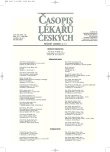Pilot Study to Evaluate Blood Glucose Control by a Model Predictive Control Algorithm with Variable Sampling Rate vs. Routine Glucose Management Protocol in Peri- and Postoperative Period in Cardiac Surgery Patients
Authors:
T. Roubíček 1; J. Křemen 1; J. Bláha 2; M. Matias 2; P. Kopecký 2; J. Rulíšek 2; K. Anderlová 1; L. Bošanská 1; M. Mráz 1; L. J. Chassin 3; R. Hovorka 3; Š. Svačina 1; M. Haluzík 1
Authors‘ workplace:
III. interní klinika 1. LF UK a VFN, Praha
1; Klinika kardiovaskulární chirurgie 1. LF UK a VFN, Praha
2; University of Cambridge, Velká Británie
3
Published in:
Čas. Lék. čes. 2007; 146: 868-873
Category:
Original Article
Overview
Background.
Increased blood glucose levels are frequently observed in critically ill patients. Recent studies have shown that the normalization of glycemia by intensive insulin therapy decreases mortality, length of the hospitalization and number of complications.
Methods and Results.
The aim of this pilot study was to compare blood glucose control by an automated model predictive control algorithm with variable sampling rate (eMPC) with routine glucose management protocol (RP) in peri- and postoperative period in cardiac surgery patients. 20 patients were included into this study (14 men and 6 women, mean age 68±10 let, BMI 28.3±5.0 kg/m²). 10 patients were randomized for treatment using eMPC algorithm and 10 patients for routine protocol. All patients underwent elective cardiac surgery and were treated with continuous insulin infusion to maintain glycemia in target range 4.4–6.1 mmol/l. The study duration was 24 hours. Mean blood glucose was significantly lower in eMPC vs. RP group (5.80±0.45 vs. 7.23±0.84 mmol/l, p<0.05). Percentage of time in target range was significantly higher in eMPC vs. RP group (67.6±8.7 % vs. 27.6±15.8 %, p<0.05). Percentage of time above the target range was higher in RP vs. eMPC group. Average insulin infusion rate was higher in eMPC vs. RP group (4.18±1.19 vs. 3.24±1.43 IU/hour, p<0.05). Average sampling interval was significantly shorter in eMPC vs. RP group (1.51±0.24 vs. 2.03±0.16 hour, p<0.05). No severe hypoglycaemia in either group occurred during the study.
Conclusions.
The results of our pilot study suggest that eMPC algorithm is more effective in maintaining euglycemia in peri- and post-operative period in patients after cardiac surgery and comparably safe as compared to RP.
Key words:
insulin resistance, hyperglycemia, critical illness.
Labels
Addictology Allergology and clinical immunology Angiology Audiology Clinical biochemistry Dermatology & STDs Paediatric gastroenterology Paediatric surgery Paediatric cardiology Paediatric neurology Paediatric ENT Paediatric psychiatry Paediatric rheumatology Diabetology Pharmacy Vascular surgery Pain management Dental HygienistArticle was published in
Journal of Czech Physicians

Most read in this issue
- Significance of Serum Antibodies ANCA, ASCA, ABBA in Diagnostics of Idiopathic Intestinal Inflammations
- Nutrigenetics and Nutrigenomics
- Thromboembolism in Pregnancy – Physiology and Pathophysiology of Hemocoagulation Changes During Normal and Pathological Gravidity
- Changes of Plasminogen Activator Inhibitor (PAI-1) During Estrogen Replacement Therapy
